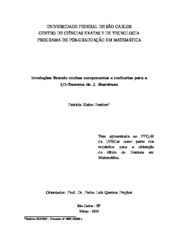Involuções fixando muitas componentes e melhorias para o 5/2-Teorema de J. Boardman
Abstract
Let (Mm; T) be a smooth involution on a closed smooth m-dimensional manifold and F = n [j=0 Fj (n < m) its fixed point set, where Fj denotes the union of those components of F having dimension j. The famous Five Halves Theorem of J. Boardman, announced in 1967, establishes that, if F is nonbounding, then m _ 5 2n; further, this estimative is best possible. In this work, we obtain improvements of this theorem, by imposing certain conditions on F. The main result of the work is in Chapter 4, where the improvements in question are obtained by taking into account the decomposability degree of the components of F. Specifically, let ! = (i1; i2; :::; it) be a non-dyadic partition of j, 2 _ j _ n, and s!(x1; x2; :::; xj) the smallest symmetric polynomial over Z2 on degree one variables x1; x2; :::; xj containing the monomial xi1 1 xi2 2 :::xit t . Write s!(Fj) 2 Hj(Fj ;Z2) for the usual cohomology class corresponding to s!(x1; x2; :::; xj). The decomposability degree of Fj , denoted by l(Fj), is the minimum length of a non-dyadic partition ! with s!(Fj) 6= 0 (here, the length of ! = (i1; i2; :::; it) is t). Suppose the fixed point set of (Mm; T) has the form F = ( j [k=0 Fk) [ Fn, where 2 _ j < n < m and Fj is nonbounding. Write n �� j = 2pq, where q _ 1 is odd and p _ 0, and set m(n �� j) = 2n + p �� q + 1 if p _ q and m(n��j) = 2n+2p��q if p _ q. Then we prove that m _ m(n��j)+2j +l(Fj). In addition, given a non-dyadic partition ! = (i1; i2; : : : ; it) of j, 2 _ j < n, we develop a method to construct involutions (Mm; T) with F of the form F = ([k<j Fk)[Fj[Fn, where m = m(n �� j) + 2j + t and s![Fj ] 6= 0, for special values of n; j and !. In some special cases, this method shows that the above bound is best possible. For example, this gives the following improvement of the Five Halves Theorem: if the fixed point set F = n [j=0 Fj of (Mm; T) has Fn��1 and Fn nonbounding, then m _ minf2n + l(Fn��1); 2n + l(Fn)g; further, the bounds m _ 2n + l(Fn��1) and m _ 2n + l(Fn) are separately best possible. Other consequence: if the fixed point set F = n [j=0 Fj of (Mm; T) has n = 2k, k _ 3 and vii Fn��1 nonbounding, then m _ 5k �� 2, and this bound is best possible (the Five Halves Theorem says that m _ 5k). We also deal with the low codimension phenomenon, which is expressed by the fact that for certain F the codimension m �� n is too small; here, the advances obtained are concerned with the fact that, in the considered cases, the number of components of F is not limited as a function of n (in the literature one finds results of this nature with F having two, three or four components). For example, among the results obtained one has: if F has the form F = F3 [ ( n [j=0 j even Fj), with n _ 4 even, and all involved normal bundles are nonbounding, then m _ n + 4; further, this estimative is best possible. Finally, we also study bounds for the case F = Fn [ F4, considering that in the literature one has results involving F = Fn [ Fi for i = 0; 1; 2; 3. For example, we show that if the fixed set of (Mm; T) has the form F = Fn [ F4, n is odd and the normal bundle over F4 is not a boundary, then m _ n + 5; further, this bound is best possible.
